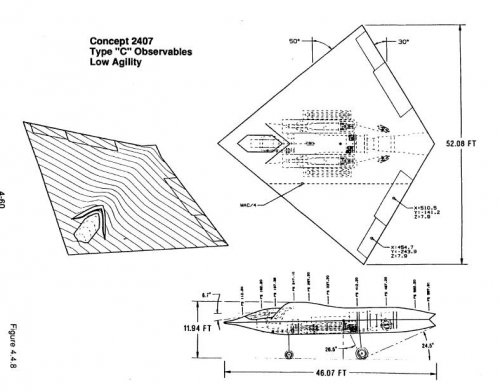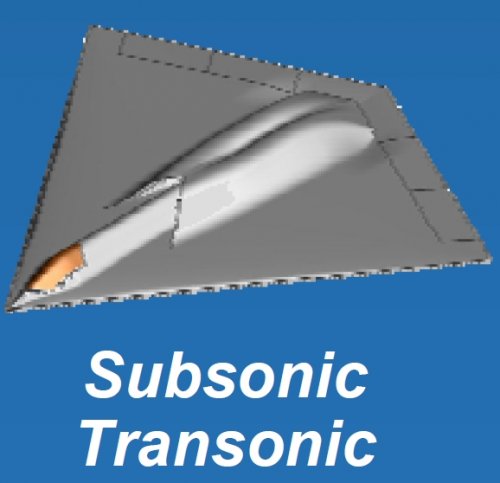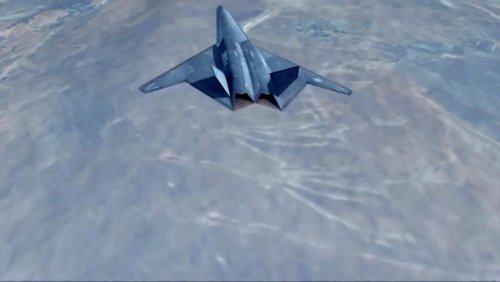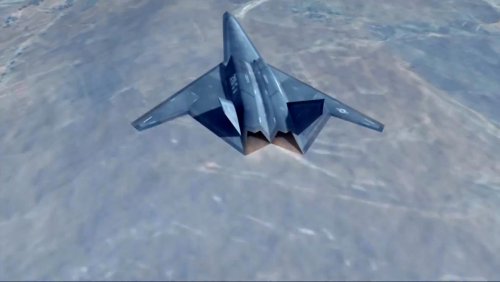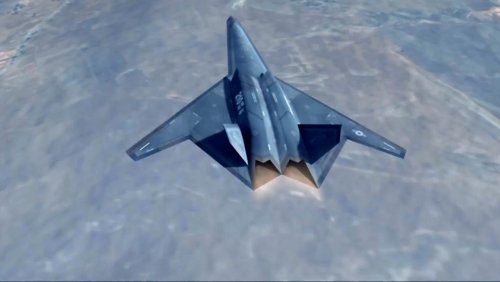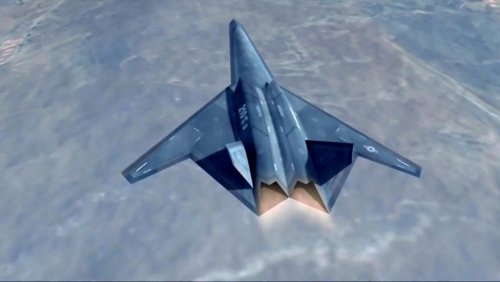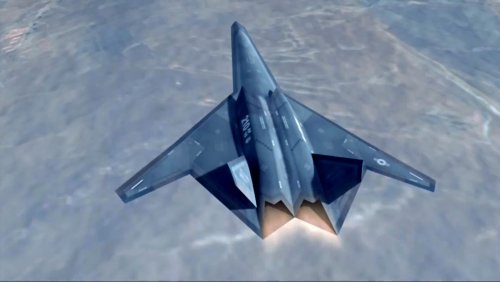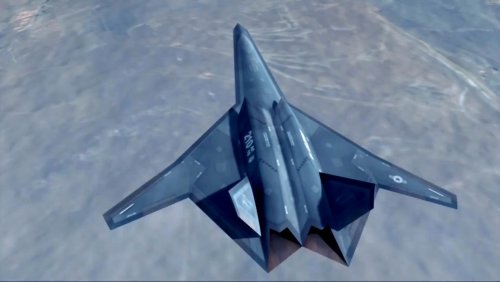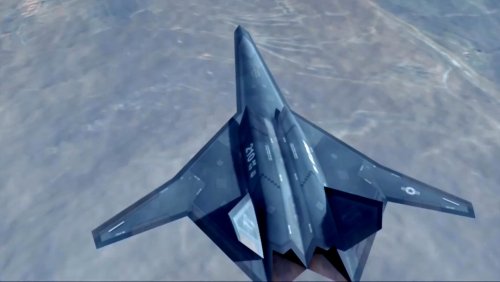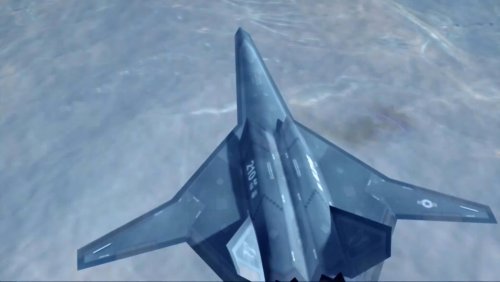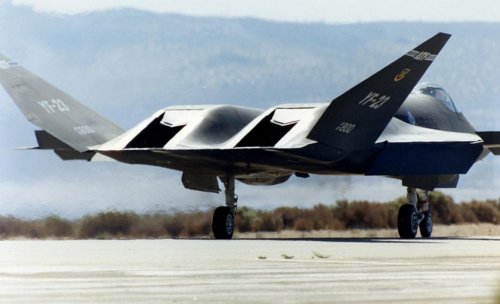You are using an out of date browser. It may not display this or other websites correctly.
You should upgrade or use an alternative browser.
You should upgrade or use an alternative browser.
US Next Generation Bomber Studies
- Thread starter flateric
- Start date
kagemusha
ACCESS: Restricted
- Joined
- 1 February 2010
- Messages
- 48
- Reaction score
- 12
flateric said:topic becoming boring w/out some pics
It's from a presentation by LM. But is this the configuration early developed with Boeing?
- Joined
- 2 August 2006
- Messages
- 3,182
- Reaction score
- 1,184
That last picture just looks like the original design for the B-2, before they redesigned it for low level penetration. I realize that could be the bottom of the design Boeing has shown, but Northrop has already designed that thirty years ago. 
- Joined
- 3 June 2011
- Messages
- 17,401
- Reaction score
- 9,184
I think the days of radically different bomber configurations may be coming to a close. (Well, unless somebody decides to pony up big bucks to go faster than subsonic anyway.) Flying wings from here on out.
- Joined
- 21 April 2009
- Messages
- 13,223
- Reaction score
- 6,126
http://www.defensenews.com/article/20140220/DEFREG02/302200043
Bomber discussion at the AFA Air Warfare Symposium via Defense News.
Bomber discussion at the AFA Air Warfare Symposium via Defense News.
- Joined
- 1 April 2006
- Messages
- 10,759
- Reaction score
- 6,842
CammNut said:The latest model of Lockheed Martin's supersonic unmanned Long Range Strike design (which it calls SSUCAS - supersonic unmanned combat air system), which was displayed at an Air Force Association symposium in Orlando in early February, had a variable geometry wing.
and yes, now we see that SSUCAS really has VG wing design
Attachments
dark sidius
ACCESS: Top Secret
- Joined
- 1 August 2008
- Messages
- 637
- Reaction score
- 222
What is the plane in the Lockheed video at 2mn15"? It looke like a new hypersonic concept ?
Steve Pace
Aviation History Writer
- Joined
- 6 January 2013
- Messages
- 2,266
- Reaction score
- 172
It's gigantic exhaust orifices scare me detection wise. -SP
- Joined
- 3 June 2011
- Messages
- 17,401
- Reaction score
- 9,184
dark sidius said:What is the plane in the Lockheed video at 2mn15"? It looke like a new hypersonic concept ?
What Lockheed video? ???
xstatic3000
ACCESS: Confidential
- Joined
- 15 September 2008
- Messages
- 95
- Reaction score
- 38
AeroFranz said:The cockpit/inlet area on the MDD aircraft looks a lot like Bird of Prey...
Definitely a lot of design language shared with Bird of Prey, and it provides a great deal of insight into where MDD/Boeing was in the 1990s.
Steve Pace said:It's gigantic exhaust orifices scare me detection wise. -SP
The F-23 exhausts seemed to limit detection effectively.
Attachments
- Joined
- 3 June 2011
- Messages
- 17,401
- Reaction score
- 9,184
Steve Pace said:It's gigantic exhaust orifices scare me detection wise. -SP
Wide and flat so they probably diffuse the exhaust pretty well.
Steve Pace
Aviation History Writer
- Joined
- 6 January 2013
- Messages
- 2,266
- Reaction score
- 172
That's PART of the reason the YF-22 beat out the YF-23. My opinion. -SP
donnage99
ACCESS: Top Secret
- Joined
- 16 June 2008
- Messages
- 1,223
- Reaction score
- 413
Steve Pace said:That's PART of the reason the YF-22 beat out the YF-23. My opinion. -SP
I think you are extremely confused. There's a difference between a large exhaust nozzle vs a large SHIELDING area for the nozzle. The latter applies to both the yf-23 and the Lockheed's SSUAS we just saw. More shielding in this particular case means stealthier. YF-23 is widely known to have a superior "buttocks" in term of stealth in comparison to the yf-22 in both RCS and IR signature reductions.
dark sidius
ACCESS: Top Secret
- Joined
- 1 August 2008
- Messages
- 637
- Reaction score
- 222
What is this Lockheed plane with folding wing a concept for the LRS-B?
ADVANCEDBOY
ACCESS: Secret
- Joined
- 3 February 2011
- Messages
- 334
- Reaction score
- 83
Shielding or no shielding. Both of these stealth aircraft are detectable by a Soviet P-18 radar. What an irony.
- Joined
- 1 April 2006
- Messages
- 10,759
- Reaction score
- 6,842
2004 UCAV concept under DARPA Morphing Aircraft Structures (MAS) programdark sidius said:What is this Lockheed plane with folding wing a concept for the LRS-B?
scaled prototype ('Yellow Bird') was built, crashed
no LRS-B connection
- Joined
- 3 June 2011
- Messages
- 17,401
- Reaction score
- 9,184
Clearly you're an expert in these matters. You should go tell Lockheed how much they don't know. :ADVANCEDBOY said:Shielding or no shielding. Both of these stealth aircraft are detectable by a Soviet P-18 radar. What an irony.
donnage99
ACCESS: Top Secret
- Joined
- 16 June 2008
- Messages
- 1,223
- Reaction score
- 413
Almost sure he is just as sarcastic as you aresferrin said:Clearly you're an expert in these matters. You should go tell Lockheed how much they don't know. :
marauder2048
"I should really just relax"
- Joined
- 19 November 2013
- Messages
- 3,157
- Reaction score
- 776
Quick question: have there been any studies into protecting the bases of a strategic bomber force (ideally a short-take-off force) with ABM sites?
- Joined
- 3 June 2011
- Messages
- 17,401
- Reaction score
- 9,184
marauder2048 said:Quick question: have there been any studies into protecting the bases of a strategic bomber force (ideally a short-take-off force) with ABM sites?
Not even in the days of Sentinal and Safeguard.
marauder2048
"I should really just relax"
- Joined
- 19 November 2013
- Messages
- 3,157
- Reaction score
- 776
sferrin said:Not even in the days of Sentinal and Safeguard.
Was that due to McNamara's general skepticism regarding the survivability of manned bombers or are there more technical/economic reasons for not investigating it?
I just wonder given the probable future force structure of the US strategic deterrent: new bomber, new SSBN, old ICBM but no ABM treaty...
- Joined
- 21 April 2009
- Messages
- 13,223
- Reaction score
- 6,126
Bomber RFP Taking Shape
A draft request for proposals for the Long-Range Strike Bomber is now out for review and comment, and a final RFP should be issued in the fall, said Air Force Secretary Deborah Lee James on Wednesday. Speaking at a Bloomberg defense symposium in Washington, D.C., James said “there are two teams at present who are working on pre-proposal-type activities, preparing to take the next step in competition” for the LRS-B. One announced competitor is the Boeing-Lockheed Martin team, and Northrop Grumman also has said it will bid. The competition will play out “in the fall timeframe,” she said, adding that “additional detail will be available next week,” when the Fiscal 2015 defense budget request is formally presented to Congress. The bomber budget “is not classified,” she said. Lt. Gen. Charles Davis, military deputy in the Office of the Assistant Secretary of the Air Force for Acquisition, told the Daily Report earlier in the day that “we’re at a point where we’re ready to begin the selection” of the bomber contractor, with a choice coming as soon as early next year. Air Force Vice Chief of Staff Gen. Larry Spencer told the Bloomberg audience that USAF has labored to constrain “the temptation to put more stuff on this bomber” and to keep it within the allowed $550 million unit cost, but “the folks working on this program are really working hard to get us the capabilities we need for that price…They’re really pushing the envelope.”
A draft request for proposals for the Long-Range Strike Bomber is now out for review and comment, and a final RFP should be issued in the fall, said Air Force Secretary Deborah Lee James on Wednesday. Speaking at a Bloomberg defense symposium in Washington, D.C., James said “there are two teams at present who are working on pre-proposal-type activities, preparing to take the next step in competition” for the LRS-B. One announced competitor is the Boeing-Lockheed Martin team, and Northrop Grumman also has said it will bid. The competition will play out “in the fall timeframe,” she said, adding that “additional detail will be available next week,” when the Fiscal 2015 defense budget request is formally presented to Congress. The bomber budget “is not classified,” she said. Lt. Gen. Charles Davis, military deputy in the Office of the Assistant Secretary of the Air Force for Acquisition, told the Daily Report earlier in the day that “we’re at a point where we’re ready to begin the selection” of the bomber contractor, with a choice coming as soon as early next year. Air Force Vice Chief of Staff Gen. Larry Spencer told the Bloomberg audience that USAF has labored to constrain “the temptation to put more stuff on this bomber” and to keep it within the allowed $550 million unit cost, but “the folks working on this program are really working hard to get us the capabilities we need for that price…They’re really pushing the envelope.”
i hope this is not too much off topic but i just want to say some exciting times are ahead of us. after the post cold war lull, finally we'll be seeing two if not three new bomber designs throughout the world. I counted eight medium or heavy bombers entering service in 1950s, two more in 1960s, one in 1970s, two in 1980s and, of course, B2 in 1990s, being a late product of Cold war. So then after no new bombers in naughties and 2010s, it's pretty sweet that we'll see not just the new US bomber but also new russian bomber and possibly new (first) chinese bomber entering service in 2020s.
If the RFP does indeed get finalized in the fall of this year, i'd guess a single project may get picked and greenlighted by the end of 2015? PAK-DA got its project picked and greenlit in 2013, with first flight planned for 2019/2020. It's possible we'll be seeing first flight of US bomber not long after that, around 2021/2022. And who knows how far along are the Chinese, theirs could also be unveiled within similar timeframe.
If the RFP does indeed get finalized in the fall of this year, i'd guess a single project may get picked and greenlighted by the end of 2015? PAK-DA got its project picked and greenlit in 2013, with first flight planned for 2019/2020. It's possible we'll be seeing first flight of US bomber not long after that, around 2021/2022. And who knows how far along are the Chinese, theirs could also be unveiled within similar timeframe.
- Joined
- 21 April 2009
- Messages
- 13,223
- Reaction score
- 6,126
http://www.defensenews.com/article/20140302/DEFREG02/303020019
They imply that due to budget issues they may start to disclose more information of the NGB's progress??
They imply that due to budget issues they may start to disclose more information of the NGB's progress??
- Joined
- 6 August 2007
- Messages
- 3,043
- Reaction score
- 2,440
bobbymike said:http://www.defensenews.com/article/20140302/DEFREG02/303020019
They imply that due to budget issues they may start to disclose more information of the NGB's progress??
Err.... more than what has already been made public? There is a LOT of information on these programs available today.
- Joined
- 21 April 2009
- Messages
- 13,223
- Reaction score
- 6,126
http://www.aviationweek.com/Blogs.aspx?plckBlogId=Blog:27ec4a53-dcc8-42d0-bd3a-01329aef79a7&plckPostId=Blog:27ec4a53-dcc8-42d0-bd3a-01329aef79a7Post:40086c9d-193c-42a2-9d85-49451648a087
Study calls for more long range airpower. I agree (for what it's worth )
)
http://www.csbaonline.org/publications/2014/03/toward-a-balanced-combat-airforce/
Study calls for more long range airpower. I agree (for what it's worth
http://www.csbaonline.org/publications/2014/03/toward-a-balanced-combat-airforce/
- Joined
- 21 April 2009
- Messages
- 13,223
- Reaction score
- 6,126
Air Force Brass: New Bomber to Exceed $550 Million Each
March 6, 2014
The price tag of the Air Force's new strategic bomber will likely exceed $550 million a unit, the service's military deputy for acquisition said on Wednesday. "We get a lot of questions" on per-unit cost, Air Force Lt. Gen. Charles Davis said at an aviation technologies conference. "Is it going to be $550 million a copy? No, of course it's not going to be $550 million a copy, once you add in everything," Defense News quoted him as saying. The Air Force in 2010 projected it would cost $550 million to acquire each of the 80 to 100 long-range strike aircraft it intends to buy. Officials have said it would be important not to exceed that figure so that skyrocketing procurement expenditures of the past would not be repeated, the publication reported. Air Force Chief of Staff Gen. Mark Welsh in November said the service would do everything it could to cap the per-unit cost at that level and would limit what technologies were included in the heavy bomber in order to meet the goal. Davis, however, indicated there was some wiggle room to that.
"What it will be is $550 million in design constraints," the three-star general said. "So if we're going to set design constraints ... that limits the technology you bring in, it limits certain parameters and certain capabilities. By definition we have used a cost-controlled approach to that airplane to be able to curb some of the appetite we have for very new capabilities." The envisioned bomber would have the ability to carry both nuclear and conventional weapons. Few other details about its desired capabilities are known, though future versions of the aircraft could be designed to be remotely piloted. Some outside analysts have been dubious about the Air Force's stated intention to limit the aircraft's costs, citing the service's long track-record of going over budget on big procurement initiatives. The Pentagon is requesting $914 million in fiscal 2015 funds to continue design work for the aircraft.
Air Force Secretary Deborah Lee James late last month said she anticipates a request for proposal on the bomber to be issued this fall, Defense News reported separately.
March 6, 2014
The price tag of the Air Force's new strategic bomber will likely exceed $550 million a unit, the service's military deputy for acquisition said on Wednesday. "We get a lot of questions" on per-unit cost, Air Force Lt. Gen. Charles Davis said at an aviation technologies conference. "Is it going to be $550 million a copy? No, of course it's not going to be $550 million a copy, once you add in everything," Defense News quoted him as saying. The Air Force in 2010 projected it would cost $550 million to acquire each of the 80 to 100 long-range strike aircraft it intends to buy. Officials have said it would be important not to exceed that figure so that skyrocketing procurement expenditures of the past would not be repeated, the publication reported. Air Force Chief of Staff Gen. Mark Welsh in November said the service would do everything it could to cap the per-unit cost at that level and would limit what technologies were included in the heavy bomber in order to meet the goal. Davis, however, indicated there was some wiggle room to that.
"What it will be is $550 million in design constraints," the three-star general said. "So if we're going to set design constraints ... that limits the technology you bring in, it limits certain parameters and certain capabilities. By definition we have used a cost-controlled approach to that airplane to be able to curb some of the appetite we have for very new capabilities." The envisioned bomber would have the ability to carry both nuclear and conventional weapons. Few other details about its desired capabilities are known, though future versions of the aircraft could be designed to be remotely piloted. Some outside analysts have been dubious about the Air Force's stated intention to limit the aircraft's costs, citing the service's long track-record of going over budget on big procurement initiatives. The Pentagon is requesting $914 million in fiscal 2015 funds to continue design work for the aircraft.
Air Force Secretary Deborah Lee James late last month said she anticipates a request for proposal on the bomber to be issued this fall, Defense News reported separately.
- Joined
- 21 April 2009
- Messages
- 13,223
- Reaction score
- 6,126
3/11/2014 - National Defense Magazine Blog
Air Force Official Promises More Openness on Long Range Bomber Competition
By Stew Magnuson
The Air Force has heretofore been reluctant to share details about the requirements and strategy for acquiring its next-generation long-range strike bomber, but that will soon change, promised the service's second highest ranking civilian. "I expect, yes, that we will be revealing more details, and we will be more transparent on that program as we move forward and move further into it than we are right now," Eric Fanning, undersecretary of the Air Force, told Washington, D.C.- based reporters. There has not been any change to the plan to produce the bomber at the stated price tag of $550 million per aircraft, he added. "We are still using that as a pretty firm chalk line for those companies that are bidding on it," he said. There are skeptics who believe the $550 million price is too low, and that the Air Force will not get the requirements out of the bomber that it needs, he said. "This is keeping both the Air Force and the contractors pretty disciplined about what they put into the bomber," he said. The price of $550 million per aircraft figure does not factor in the development costs, he said. He didn't know what the per unit cost what be if the R&D was added, but it wouldn't double it, he said. The Air Force has not settled on an acquisition strategy for the bomber, he added. "The competition that is in place right now is, in my view, pretty substantial." The contractors that are teaming up are already investing a lot of their own dollars gearing up for the program, he said.
The $550 million per aircraft production cost target is prompting the Air Force and the contractors to make trade offs on requirements, he said. The long-range bomber is still considered part of a "family of systems," which will include new sensors, weapons and other components beyond the airframe, Fanning said, although he declined to go into further details. There is also early research-and-development funding in the pipeline for a sixth-generation fighter, he said. "Even as we're producing the fifth-generation joint strike fighter, we need to invest into the research, science and technology necessary to be looking at sixth generation. It's in the budget," he said, although the documents for the long range budgets have not been released yet. He didn't know offhand how much would be committed to the future fighter. As for legacy platforms that the Air Force is hoping to retire if Congress gives its approval, such as the A-10 Warthog and U-2 spy plane, Fanning said money will have to come out of its budget if the service has to keep them in its inventory. "Certainly, if we have to keep the A-10 and the U-2, something else is going to have to give," he said. There are "very big variables out there," he said, referring to the budget past 2015, when sequestration may take hold again. Choosing the unmanned Global Hawk over the U-2 as the Air Force's primary spy plane was more than simply looking at the cost per flight hour, he said. The Global Hawk is newer, more capable, and can fly longer distances, he said. The contractor, Northrop Grumman, has wrung savings out of the program in terms of logistics, to give it an edge over the U-2, he added. Fanning also addressed whether the crisis in the Ukraine and a possible trade embargo with Russia would affect supplies of the RD-180 rocket engine, which the U.S. launch industry buys for its Atlas III rockets. "I have not seen anything on either side suggesting that that supply is in jeopardy," he said.
Air Force Official Promises More Openness on Long Range Bomber Competition
By Stew Magnuson
The Air Force has heretofore been reluctant to share details about the requirements and strategy for acquiring its next-generation long-range strike bomber, but that will soon change, promised the service's second highest ranking civilian. "I expect, yes, that we will be revealing more details, and we will be more transparent on that program as we move forward and move further into it than we are right now," Eric Fanning, undersecretary of the Air Force, told Washington, D.C.- based reporters. There has not been any change to the plan to produce the bomber at the stated price tag of $550 million per aircraft, he added. "We are still using that as a pretty firm chalk line for those companies that are bidding on it," he said. There are skeptics who believe the $550 million price is too low, and that the Air Force will not get the requirements out of the bomber that it needs, he said. "This is keeping both the Air Force and the contractors pretty disciplined about what they put into the bomber," he said. The price of $550 million per aircraft figure does not factor in the development costs, he said. He didn't know what the per unit cost what be if the R&D was added, but it wouldn't double it, he said. The Air Force has not settled on an acquisition strategy for the bomber, he added. "The competition that is in place right now is, in my view, pretty substantial." The contractors that are teaming up are already investing a lot of their own dollars gearing up for the program, he said.
The $550 million per aircraft production cost target is prompting the Air Force and the contractors to make trade offs on requirements, he said. The long-range bomber is still considered part of a "family of systems," which will include new sensors, weapons and other components beyond the airframe, Fanning said, although he declined to go into further details. There is also early research-and-development funding in the pipeline for a sixth-generation fighter, he said. "Even as we're producing the fifth-generation joint strike fighter, we need to invest into the research, science and technology necessary to be looking at sixth generation. It's in the budget," he said, although the documents for the long range budgets have not been released yet. He didn't know offhand how much would be committed to the future fighter. As for legacy platforms that the Air Force is hoping to retire if Congress gives its approval, such as the A-10 Warthog and U-2 spy plane, Fanning said money will have to come out of its budget if the service has to keep them in its inventory. "Certainly, if we have to keep the A-10 and the U-2, something else is going to have to give," he said. There are "very big variables out there," he said, referring to the budget past 2015, when sequestration may take hold again. Choosing the unmanned Global Hawk over the U-2 as the Air Force's primary spy plane was more than simply looking at the cost per flight hour, he said. The Global Hawk is newer, more capable, and can fly longer distances, he said. The contractor, Northrop Grumman, has wrung savings out of the program in terms of logistics, to give it an edge over the U-2, he added. Fanning also addressed whether the crisis in the Ukraine and a possible trade embargo with Russia would affect supplies of the RD-180 rocket engine, which the U.S. launch industry buys for its Atlas III rockets. "I have not seen anything on either side suggesting that that supply is in jeopardy," he said.
- Joined
- 21 April 2009
- Messages
- 13,223
- Reaction score
- 6,126
Bomber Plans
The Air Force has not quite “settled on the exact acquisition strategy” for the Long-Range Strike Bomber, service Undersecretary Eric Fanning told reporters in Washington, D.C., Tuesday. However, the competition “in place right now” for the LRS-B “is . . . pretty substantial.” Secretary Deborah Lee James recently announced the program would go out for bid by the end of the year. “Those that are teeing up to bid” have invested heavily in the LRS-B, Fanning said. Industry sources have suggested that the competing teams of Boeing/Lockheed Martin and Northrop Grumman have produced subscale demonstrators of the aircraft at their own expense. The Air Force is holding to a flyaway cost of $550 million each as “a pretty firm chalkline,” and Fanning said it has helped the service and contractors maintain requirements discipline. He allowed that “there are a number of people who think it’s too low of a number and we’re not going to get the requirements out of the bomber that we need,” but USAF is “hewing . . . pretty hard to that number.” Fanning also told the Daily Report the LRS-B depends on “enablers” that have been little discussed. “I hate that term,” he said, “because it sounds like it’s a ‘nice to have’ item. And it’s not. It’s necessary.” He said USAF will soon be “more transparent” about the bomber, but it will take longer to discuss the “enablers.”
The Air Force has not quite “settled on the exact acquisition strategy” for the Long-Range Strike Bomber, service Undersecretary Eric Fanning told reporters in Washington, D.C., Tuesday. However, the competition “in place right now” for the LRS-B “is . . . pretty substantial.” Secretary Deborah Lee James recently announced the program would go out for bid by the end of the year. “Those that are teeing up to bid” have invested heavily in the LRS-B, Fanning said. Industry sources have suggested that the competing teams of Boeing/Lockheed Martin and Northrop Grumman have produced subscale demonstrators of the aircraft at their own expense. The Air Force is holding to a flyaway cost of $550 million each as “a pretty firm chalkline,” and Fanning said it has helped the service and contractors maintain requirements discipline. He allowed that “there are a number of people who think it’s too low of a number and we’re not going to get the requirements out of the bomber that we need,” but USAF is “hewing . . . pretty hard to that number.” Fanning also told the Daily Report the LRS-B depends on “enablers” that have been little discussed. “I hate that term,” he said, “because it sounds like it’s a ‘nice to have’ item. And it’s not. It’s necessary.” He said USAF will soon be “more transparent” about the bomber, but it will take longer to discuss the “enablers.”
dark sidius
ACCESS: Top Secret
- Joined
- 1 August 2008
- Messages
- 637
- Reaction score
- 222
Subscale demonstrator ? 
- Joined
- 1 April 2006
- Messages
- 10,759
- Reaction score
- 6,842
I have an impression that you were sleeping for the last 6 years.dark sidius said:Subscale demonstrator ?
http://www.secretprojects.co.uk/forum/index.php/topic,191.msg35512.html#msg35512
dark sidius
ACCESS: Top Secret
- Joined
- 1 August 2008
- Messages
- 637
- Reaction score
- 222
With my respect, since 6 years there is not a real single picture about the new bomber, just concept and illustrated drawing and a mix between ancient long range strike projects but no concrete picture about the LRS-B. The next year, will be surely interesting and this time may be real picture, will be disclose in the competition for the new bomber.
- Joined
- 1 April 2006
- Messages
- 10,759
- Reaction score
- 6,842
yep, they really got out of hand lately and don't report to forum about state of classified programs running...dark sidius said:With my respect, since 6 years there is not a real single picture about the new bomber, just concept and illustrated drawing and a mix between ancient long range strike projects but no concrete picture about the LRS-B.
Similar threads
-
ASD Preliminary Designs in Splendid Vision, Unswerving Purpose
- Started by XP67_Moonbat
- Replies: 16
-
Strategic/Theatre/Vertical Configurable Air Transports (S-CAT, T-CAT, V-CAT)
- Started by Stargazer
- Replies: 15
-
-
-

